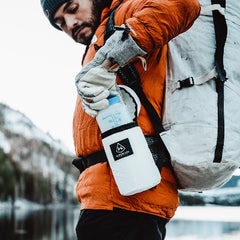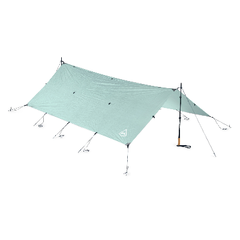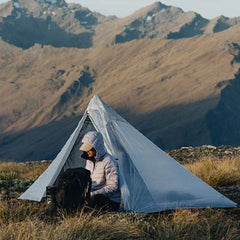Hyperlite Mountain Gear Ambassador Steve Graepel is about to leave on a fatbiking expedition on Oregon Coast. In this post, he gives us his approach to gear selection and going light when planning a multisport expedition like this one.
Words by Steve Graepel
Thanks to the 1967 Oregon Beach Bill, the public has unrestricted easement to the Oregon Coast, where uninterrupted miles of beach are periodically punctuated by the western slope drainage and rocky capes. In a few days, a buddy and I are heading west with fatbikes to pedal and paddle a rough cut of the coast between Port Orford and Florence. During the trip, we’ll be employing some familiar and some orthodox strategies.
Awkwardly enough, to save weight, we needed to put on a little “fat”. While lugging a 30 pound bike with monster truck wheels the size of Montana seems far from light, sometimes the terrain dictates the gear. And in sand, size matters. With 3.7” of volume, I’m actually on the terminal edge of the fat movement (new tires are breaking into the 5” barrier). While I’d probably appreciate the extra float, the loss of over an inch trims a weight in rims and tires while still providing sufficient float.
I’ve cut additional bike weight with a few aftermarket upgrades. The stock crankset was replaced with a 36/22 crankset and a single 18 cog in the back. For the layman, this means I have two rings in front but one ring in the rear, enabling smooth pedaling in soft sand and an efficient gear for the hard pack. I swapped in a titanium handlebar and seatpost; it is corrosion resistant and “softens” the ride in the cockpit – which the prostate will appreciate after miles on the John Deere tires. Lastly, we’ve stripped the front brakes. Salt and sand is hard on brakes and cable gets in the way of handlebar bags. Removing the brakes also simplifies the constant removal and mounting of the front wheel and it lessens the chance of a fatal snag during the inevitable bushwhack. In the end, all these trimmings cut about 7 pounds off the market bike.
When cycling, weight on the body fatigues the body. And carrying an additional 30 pounds of supplies wreaks havoc on the ischial tuberosity (read as saddle sores). So most supplies will be loaded on the bike, not in the pack. A bevy of Revelate Designs frame bags bought us some real estate on the handlebars, the seatpost and inside the frame triangle. We’ll strategically pack gear to keep the bike’s center stable and squirreliness minimized: lighter, bulkier gear will go on the handlebars; heavy and incompressible (food) will pack in the frame bag; bulky electronics will stow in the seatpost drybag.
The route isn’t all sand. As I alluded to, we’ll fjord the inlets and rivers that cross our route. Traditionally, bikes are precariously strapped to packrafts to navigate water crossings. We’ll be doing the same. But the packraft market has seen some radical enlightenment. Last year Klymit (mostly known for inflatable pads and jackets), threw its design in the pool with its LWD, or Light Weight Dingy. The material is a 210D ripstop nylon–something you would find in an inflatable pad–has 6 lash points, an ingenious unidirectional valve, and comes with an inflation bag/dry bag. As you would assume by the name, it’s light and is best suited for flat to mildly wavy water with minimal rock or exposure to pokey things; entirely within the scope of our route. Finally, the LWD weighs 35oz – nearly 4 pounds lighter than my skirted Alpackaraft Yukon. A few test rides look like it’s a winner and can support a fully loaded bike and paddler. It will be wet, but it’s Oregon after all.
We’ll use a Hyperlite Mountain Gear Windrider Pack and a Hyperlite Mountain Gear Porter Pack to stow what we can’t fit on the bike, which won’t be much. Water, supplies for the day, paddles and the boat. The theory is to keep it light, but have enough volume to carry all our supplies during hike-a-bike section. Hell biking can be, well, a slice out of purgatory when you have to push unwieldy loaded bikes. By comparison, hauling supplies on the back lets big tires virtually float over the terrain.
Bike and boat aside, the real savings starts to accrue in the traditional ways. Just like when backpacking, we’re going light where we can afford to and cutting what we don’t need: shared camp equipment, one set of pedal clothes, one set of camp clothes and lightweight rain gear to cover over it all. The weather will still warm – 55 degrees at night – so we can cut a significant amount in insulation weight. I’m using a warm weather quilt by Katabatic gear and a lightweight parka. We’re using Hyperlite Mountain Gear’s new 2-man UltaMid pyramid tent, and our ½ length 6 oz. ‘skeletal’ Klymit pad will double as our PFD.
Stripping a kit down its raw bones integrates gear into the fabric of the pursuit. And you’d be hard pressed to find a pursuit that exemplifies this more so than multisport. It requires creativity, a savvy approach, and a measure of moxi. The challenges are proportional but the rewards are exponential. The Oregon Coast should be a great proving ground for our bikepacking strategy.
-Steve Graepel, September 2013
The post Pack Lite: Oregon Coast Fatbiking appeared first on Hyperlite Mountain Gear Blog.



















